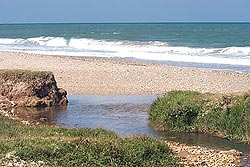|
 Tyre
Coast Nature Reserve is not only a Nature reserve but also
a Ramsar site. Tyre
Coast Nature Reserve is not only a Nature reserve but also
a Ramsar site.
Located in Southern Lebanon expanding over 380 ha, Tyre Coast
Nature Reserve remains the largest sandy beach in Lebanon.
Besides its importance for visitors’ entertainment, Tyre
Coast Nature Reserve harbors many species of plants, animals and
insects.
It is a nesting site for the endangered Loggerhead and green
sea Turtle and the shelter of the Arabian spiny mouse and many
other important creatures.
Tyre Coast Nature Reserve is of a particular importance for
the following purpose:
- Fresh water
estuaries and springs that outflow to the sea thus creating
fresh/marine water interface.
- Habitat for sea turtles
- Last and largest remaining sandy beach in Lebanon
- Divided into three main zones:
1- A
beach zone
2- A
high conservation zone that includes the Phoenician springs of Ras
El Ain.
3- A
large area for agriculture
Tyre
Coast
Reserve
is cut into two segments by the Rashidiyeh Refugee camp.
Access to
the
Ras al-Ain beach part is limited since it disturbs wildlife. This
section
provides a freshwater habitat and the off-flow creates small areas
rich in frogs and other amphibians.
The inflow of
fresh water creates brackish water rich in aquatic species.
On the
other
hand the northern part is open to the public for swimming and
relaxation.
|
History
and culture
 Ras el-Ain has
been known since the Phoenician days for being the main source of
irrigation and drinking water for Tyre. Its artesian wells gush up
into stone reservoirs that have been maintained through the ages.
One of the reservoirs fed the arched aqueducts of the Roman period
that once stretched all the way to Tyre. A short stretch of the
original aqueductnear the reservoirs continues to serve as part of
Tyre’s present day waterworks. Ras el-Ain has
been known since the Phoenician days for being the main source of
irrigation and drinking water for Tyre. Its artesian wells gush up
into stone reservoirs that have been maintained through the ages.
One of the reservoirs fed the arched aqueducts of the Roman period
that once stretched all the way to Tyre. A short stretch of the
original aqueductnear the reservoirs continues to serve as part of
Tyre’s present day waterworks.
|
|
|
|
|
|
|